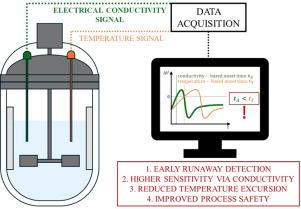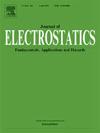Electrical conductivity as an indicator for early warning detection systems in chemical reactors
IF 2.1
4区 工程技术
Q3 ENGINEERING, ELECTRICAL & ELECTRONIC
引用次数: 0
Abstract
Early Warning Detection Systems (EWDS) are essential for preventing runaway reactions in chemical reactors by providing timely alerts before uncontrolled exothermic events. Conventional EWDS rely predominantly on temperature monitoring; however, industrial temperature sensors often suffer from delayed response and are highly dependent on sensor positioning, limiting their effectiveness during rapid or localized thermal excursions.
This study introduces an alternative detection strategy based on electrical conductivity monitoring, which offers faster response times and higher sensitivity—especially in reactions where ionic or charged species are released at the onset of runaway. A theoretical framework is presented to demonstrate how this method can overcome key limitations of temperature-based systems, enabling more accurate and responsive detection.
Compared to the benchmark divergence method, the conductivity-based approach detects runaway onset within 2 °C of the true temperature (vs. 3 °C deviation with temperature sensors), and anticipates the event 200–300 s before peak temperature. This allows earlier intervention and significantly reduces the maximum temperature rise at onset (by 30%–40% compared to temperature-based detection). Integrating advanced conductivity sensors into existing EWDS infrastructures could markedly improve reactor safety and control. This work lays the foundation for future experimental validation and broader adoption in chemical reaction engineering safety systems.

电导率作为化学反应器预警检测系统的指标
早期预警检测系统(EWDS)通过在未控制的放热事件发生前提供及时警报,对防止化学反应器中的失控反应至关重要。传统的EWDS主要依赖于温度监测;然而,工业温度传感器经常受到延迟响应的影响,并且高度依赖于传感器定位,这限制了它们在快速或局部热漂移时的有效性。本研究介绍了一种基于电导率监测的替代检测策略,它提供了更快的响应时间和更高的灵敏度-特别是在失控开始时释放离子或带电物质的反应中。提出了一个理论框架来证明这种方法如何克服基于温度的系统的关键限制,从而实现更准确和响应更快的检测。与基准发散方法相比,基于电导率的方法可以在真实温度的2°C范围内检测到失控的发生(与温度传感器的偏差为~ 3°C),并在峰值温度前200-300秒预测事件。这使得早期干预成为可能,并显著降低了发病时的最高温升(与基于温度的检测相比降低了30%-40%)。将先进的电导率传感器集成到现有的EWDS基础设施中可以显著提高反应堆的安全性和控制。这项工作为未来的实验验证和在化学反应工程安全系统中的广泛应用奠定了基础。
本文章由计算机程序翻译,如有差异,请以英文原文为准。
求助全文
约1分钟内获得全文
求助全文
来源期刊

Journal of Electrostatics
工程技术-工程:电子与电气
CiteScore
4.00
自引率
11.10%
发文量
81
审稿时长
49 days
期刊介绍:
The Journal of Electrostatics is the leading forum for publishing research findings that advance knowledge in the field of electrostatics. We invite submissions in the following areas:
Electrostatic charge separation processes.
Electrostatic manipulation of particles, droplets, and biological cells.
Electrostatically driven or controlled fluid flow.
Electrostatics in the gas phase.
 求助内容:
求助内容: 应助结果提醒方式:
应助结果提醒方式:


